Panasonic AG-HPX172EN User Manual
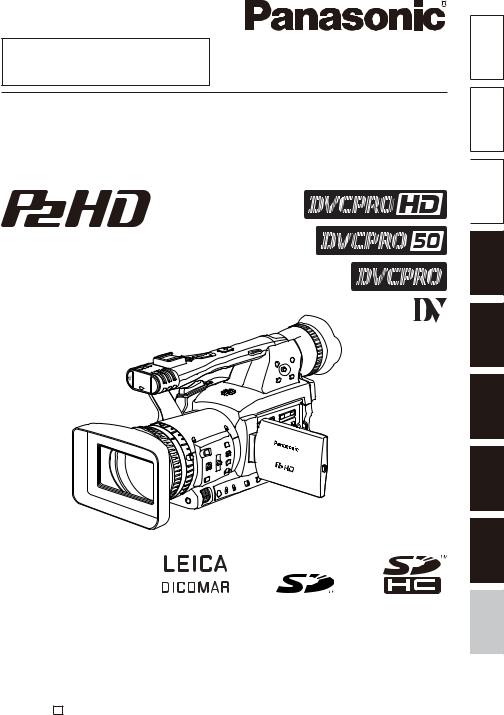
This product is eligible for the P2HD 5 Year Warranty Repair Program. For
details, see page 4. |
Operating Instructions |
|
Memory Card Camera-Recorder
Model No. AG-HPX172EN
Before operating this product, please read the instructions carefully and save this manual for future use.
 Reference Menu Displays Editing Playback Shooting Preparation Description of Before use parts
Reference Menu Displays Editing Playback Shooting Preparation Description of Before use parts
F0808T0 -P D |
ENGLISH |
|
Printed in Japan VQT1U95
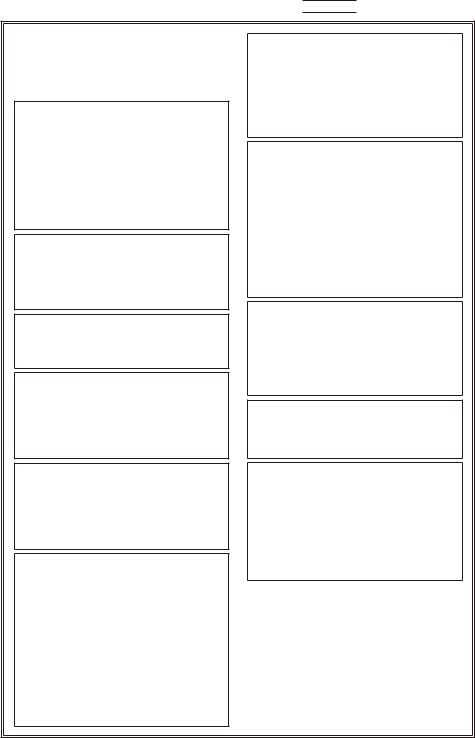
Read this first!



 indicates safety information.
indicates safety information.
G DO NOT REMOVE PANEL COVERS
BY UNSCREWING THEM.
To reduce the risk of electric shock, do not remove cover. No user serviceable parts inside.
Refer servicing to qualified service personnel.
WARNING:
•TO REDUCE THE RISK OF FIRE OR SHOCK HAZARD, DO NOT EXPOSE THIS EQUIPMENT TO RAIN OR MOISTURE.
•TO REDUCE THE RISK OF FIRE OR SHOCK HAZARD, KEEP THIS EQUIPMENT AWAY FROM ALL LIQUIDS. USE AND STORE ONLY IN LOCATIONS WHICH ARE NOT EXPOSED TO THE RISK OF DRIPPING OR SPLASHING LIQUIDS, AND DO NOT PLACE ANY LIQUID CONTAINERS ON TOP OF THE EQUIPMENT.
WARNING:
Always keep memory cards or accessories (coin battery, microphone holder screws, microphone holder adapter, ferrite cores, INPUT terminal cover) out of the reach of babies and small children.
CAUTION:
TO REDUCE THE RISK OF FIRE OR SHOCK HAZARD AND ANNOYING INTERFERENCE, USE THE RECOMMENDED ACCESSORIES ONLY.
CAUTION:
In order to maintain adequate ventilation, do not install or place this unit in a bookcase, built-in cabinet or any other confined space.To prevent risk of electric shock or fire hazard due to overheating, ensure that curtains and any other materials do not obstruct the ventilation.
CAUTION:
Do not lift the unit by its handle while the tripod is attached. When the tripod is attached, its weight will also affect the unit’s handle, possibly causing the handle to break and hurting
the user. To carry the unit while the tripod is attached, take hold of the tripod..
CAUTION:
Danger of explosion or fire if battery is mistreated.
For Battery Pack
•Replace only with same or specified type.
•Do not disassemble or dispose of in fire.
•Do not store in temperatures over 60°C.
•Do not leave the battery in an automobile exposed to direct sunlight for a long period of time with doors and windows closed.
•Use specified charger.
For Battery of Remote Controller
•Replace battery with part No. CR2025 only.
•Do not recharge the battery.
•Do not disassemble or dispose of in fire.
•Do not store in temperatures over 60°C.
Camera-Recorder
The rating plate is on the underside of the viewfinder.
AC Adapter
The rating plate is on the underside of the AC Adapter.
Disconnect the AC mains plug from the AC mains socket when not in use.
CAUTION:
THE MAINS PLUG OF THE POWER SUPPLY CORD SHALL REMAIN READILY OPERABLE. THE AC RECEPTACLE (MAINS SOCKET OUTLET) SHALL BE INSTALLED NEAR THE EQUIPMENT AND SHALL BE EASILY ACCESSIBLE.
TO COMPLETELY DISCONNECT THIS EQUIPMENT FROM THE AC MAINS, DISCONNECT THE POWER CORD PLUG FROM THE AC RECEPTACLE.
CAUTION:
Do not jar, swing, or shake the unit by its handle while the conversion lens or another accessory is attached.
Due to the added weight of the conversion lens, any strong jolt to the handle may damage the unit or result in personal injury.
CAUTION:
EXCESSIVE SOUND PRESSURE FROM EARPHONES AND HEADPHONES CAN CAUSE HEARING LOSS.
CAUTION:
Do not leave the unit in direct contact with the skin for long periods of time when in use.
Low temperature burn injuries may be suffered if the high temperature parts of this unit are
in direct contact with the skin for long periods of time.
When using the equipment for long periods of time, make use of the tripod.

Recommendation for Use of Genuine Panasonic Battery Pack (Rechargeable Battery)
Thank you for using a Panasonic product.
It has been our policy to recommend that the genuine Panasonic battery pack be used for any Panasonic product that uses a battery pack, including digital cameras. It has, however, been found that imitation battery packs that look very similar to the genuine Panasonic battery pack are marketed in some markets.
Some of these imitation battery packs are not equipped with any protective devices that meet given quality standards for permitting use at high power outputs and for long hours.
If any of these battery packs of inferior quality is used, it could lead to an accident or failure involving firing or explosion.
To ensure that our products are used in utmost safety, we once again remind you that we recommend the use of a genuine Panasonic battery pack for any Panasonic product that is to use a battery pack. The genuine Panasonic battery packs are sold under our stringent quality control.
Please be advised that we are not liable for any accident or failure occurring as a result of use of an imitation battery pack.
We appreciate your kind understanding and cooperation in this regard.
Operating precaution
Operation near any appliance which generates strong magnetic fields may give rise to noise in the video and audio signals. If this should be the case, deal with the situation by, for instance, moving the source of the magnetic fields away from the unit before operation.
IMPORTANT
“Unauthorized recording of copyrighted television programs, video tapes and other materials may infringe the right of copyright owners and be contrary to copyright laws.”

Software information for this product
1.Customer advisory: This product includes software licensed under the GNU General Public License (GPL) and GNU Lesser General Public License (LGPL); customers have the right to download, modify, and redistribute source code for this software.
Descriptions of the GPL and LGPL are stored on the installation CD included with this camera-recorder. See the folder named \LDOC. (The description is the original (written in English).) To download the relevant source code, visit https://eww.pavc.panasonic.co.jp/pro-av/
Please note that we cannot answer any questions you may have about the content, etc. of any source code you may obtain from the above Web site.
2.This product includes software licensed under the MIT License. A description of the MIT is stored on the installation CD included with this camera-recorder. See the folder named \LDOC. (The description is the original (written in English).)
•LEICA is a trademark of Leica Microsystems IRGmbH.
•DICOMAR is a trademark of Leica Camera AG.
•SD logo is a trademark.
All other explanations, company names, and product names are the registered trademarks of the respective companies.
P2HD 5 Year Warranty Repair Program*1
Thank you for purchasing this Panasonic P2HD device.
Register as a user for this device to receive a special service warranty up to five years of free warranty repairs.
Customers who register as users on the website will receive a extended warranty repair valid for up to five years.
|
1st year |
2nd year |
3rd year |
4th year |
5th year*5 |
P2HD device*2 |
Basic warranty*3 |
|
Extended warranty repair*4 |
|
|
*1: Please note that this extended warranty is not available in some countries/regions see web |
|||||
site below for details. *2: Not all models eligible for extended warranty coverage. |
*3:The basic |
||||
warranty period may vary depending on the country/region see enclosed warranty for warranty |
|||||
coverage. *4: Not all repair work is covered by this extended warranty see enclosed warranty |
|||||
card for warranty coverage. *5:The maximum warranty period may be adjusted depending on |
|||||
the number of hours the device has been used. |
|
|
|
||
|
|
|
Free 5 years of Warranty Repairs |
Purchase |
Register online |
“Registration Notice” |
Make sure to save the “Registration Notice” |
P2 product |
within 1 month |
e-mail sent |
e-mail during the warranty period. |
Details about user registration and the extended warranty:  http://panasonic.biz/sav/pass_e
http://panasonic.biz/sav/pass_e

Contents
Read this first!...................................................... |
2 |
Recommendation for Use of Genuine |
|
Panasonic Battery Pack |
|
(Rechargeable Battery).................................... |
3 |
Software information for this product................ |
4 |
|
|
Before use |
|
Outline of operations........................................... |
7 |
Precaution for use................................................ |
8 |
Accessories.......................................................... |
9 |
Optional units....................................................... |
9 |
About this manual................................................ |
9 |
|
|
Description of parts |
|
Description of parts........................................... |
10 |
Right side and rear side................................... |
10 |
Left side........................................................... |
11 |
Terminals and mounting parts.......................... |
12 |
Remote control................................................. |
13 |
|
|
Preparation |
|
The battery.......................................................... |
14 |
Charging.......................................................... |
14 |
Installing and removing the power supply...... |
15 |
Installing and removing the battery.................. |
15 |
Connecting and disconnecting |
|
the power cord............................................. |
15 |
Adjusting the hand strap................................... |
16 |
Attaching the shoulder strap............................ |
16 |
Detaching and attaching the lens hood........... |
16 |
The remote control............................................. |
17 |
Insert the battery.............................................. |
17 |
Remote control setup....................................... |
17 |
Turn on/off the camera....................................... |
18 |
Tally lamp............................................................ |
18 |
Viewfinder........................................................... |
19 |
Using the viewfinder......................................... |
19 |
Using the LCD.................................................. |
20 |
Emphasizing outlines....................................... |
20 |
Adjusting the screen display............................ |
21 |
Adjusting the backlight..................................... |
22 |
Flipping images vertically and horizontally....... |
22 |
Switching between overscan and |
|
underscan.................................................... |
22 |
Setting the calendar........................................... |
23 |
|
|
Shooting |
|
Basic shooting operations................................ |
24 |
Preparing to shoot............................................ |
24 |
Shooting in auto mode..................................... |
24 |
Checking photos taken (REC CHECK)............ |
25 |
P2 card access lamps...................................... |
25 |
Protecting against a possible erasure.............. |
25 |
Formatting P2 cards......................................... |
25 |
Recording times............................................... |
26 |
Remove the P2 card........................................ |
27 |
Using SD/SDHC memory cards........................ |
28 |
Installing and removing |
|
the SD memory card.................................... |
28 |
Formatting SD memory card............................ |
28 |
Cautions in using SD memory cards................ |
28 |
Using the zoom function................................... |
29 |
Digital zoom function........................................ |
29 |
Variable frame rates (VFR)................................ |
30 |
Native recording............................................... |
31 |
Standard recording.......................................... |
31 |
Using variable frame rates (VFR)..................... |
32 |
Shooting in 1080i/576i progressive mode....... |
33 |
Shooting in manual mode................................. |
34 |
Switching to manual mode............................... |
34 |
Manual focusing............................................... |
34 |
Using focus assist............................................ |
35 |
Iris adjustments................................................ |
35 |
Adjusting the gain............................................ |
36 |
Light intensity adjustments............................... |
36 |
Adjusting the white balance............................. |
37 |
Black balance adjustments.............................. |
38 |
Auto Tracking White (ATW)............................... |
38 |
Shooting techniques for different targets........ |
39 |
Low-angle shooting.......................................... |
39 |
Self-portrait shooting........................................ |
39 |
Zebra pattern................................................... |
39 |
Marker.............................................................. |
39 |
Checking and displaying shooting status......... |
40 |
Changing the image size.................................. |
40 |
Optical Image Stabilizer................................... |
41 |
Adding effects to images.................................. |
41 |
Using the USER buttons.................................. |
41 |
Backlight compensation................................... |
41 |
Color bars........................................................ |
41 |
Waveform monitor function.............................. |
42 |
Adjusting the volume while shooting................ |
42 |
Backup recording............................................. |
42 |
2-slot continuous recording.............................. |
43 |
Shot mark function........................................... |
43 |
Text memo recording........................................ |
43 |
Time stamp function......................................... |
43 |
LAST CLIP DELETE function.......................... |
44 |
Using the special recording functions............. |
45 |
Pre-recording (PRE REC)................................ |
45 |
Interval recording (INTERVAL REC)................ |
45 |
One-shot recording (ONE-SHOT REC)........... |
46 |
Loop recording (LOOP REC)........................... |
46 |
Adjusting the shutter speed.............................. |
48 |
Synchro scan................................................... |
49 |

Switching Audio Input....................................... |
50 |
Using the built-in microphone........................... |
50 |
Using another microphone and |
|
audio equipment.......................................... |
50 |
Adjusting the recording level............................ |
51 |
Using scene files................................................ |
52 |
Changing scene file settings............................ |
52 |
Saving scene files and other settings on |
|
SD memory cards........................................... |
54 |
Clip metadata...................................................... |
56 |
Using the Counter.............................................. |
57 |
Counter display................................................ |
57 |
1394TC preset mode....................................... |
57 |
Charging the built-in battery/ |
|
Setting the time data...................................... |
58 |
Recharging the built-in battery......................... |
58 |
Setting the time code....................................... |
58 |
Specifying the time code (TC PRESET).......... |
58 |
Setting user information................................... |
60 |
|
|
Playback |
|
Basic playback operations................................ |
62 |
Thumbnail screen.............................................. |
63 |
Basic thumbnail screen operations.................. |
63 |
Adding shot marks to clips............................... |
65 |
Clearing the thumbnail screen......................... |
65 |
Direct shooting functions.................................. |
65 |
Thumbnail operations........................................ |
66 |
Selecting the thumbnail display method |
|
(THUMBNAIL).............................................. |
66 |
Deleting clips and formatting cards |
|
(OPERATION).............................................. |
67 |
Checking the clip or card information |
|
(PROPERTY)............................................... |
68 |
Editing the recorded clip metadata.................. |
70 |
Uploading the metadata (META DATA)............ |
71 |
Useful playback functions................................. |
73 |
Variable speed search...................................... |
73 |
Slow playback.................................................. |
73 |
Fast forward/rewind playback........................... |
73 |
Frame-by-frame playback................................. |
73 |
Clip skip........................................................... |
74 |
Adjusting the volume........................................ |
74 |
Viewing images on a monitor........................... |
74 |
Checking the date and time............................. |
74 |
|
|
Editing |
|
Connecting external units................................. |
75 |
Headphones..................................................... |
75 |
External microphone........................................ |
75 |
Computer (non-linear editing/file transfer)........ |
76 |
Hard disk drive (data copying)......................... |
77 |
Digital video equipment (Dubbing)................... |
78 |
Video deck (Dubbing)....................................... |
79 |
TV/Monitor (playback/dubbing)........................ |
79 |
Nonlinear editing with P2 card (PC mode)....... |
80 |
Copying from P2 cards to |
|
the hard disk drive (1394 HOST mode)........ |
82 |
Warnings.......................................................... |
84 |
Dubbing............................................................... |
85 |
Digital input/output........................................... |
85 |
Analog output................................................... |
85 |
|
|
Displays |
|
Screen displays.................................................. |
86 |
Regular displays............................................... |
86 |
Warnings.......................................................... |
90 |
Setting the DISPLAY items.............................. |
92 |
|
|
Menu |
|
Using the setup menus...................................... |
93 |
Using the menus.............................................. |
93 |
Initializing the menu settings............................ |
94 |
Setup menu structure........................................ |
95 |
CAM (camera) mode menu.............................. |
95 |
MCR (playback) mode menu............................ |
96 |
Setup menu list.................................................. |
97 |
SCENE FILE screen........................................ |
97 |
CAMERA SETUP screen................................. |
99 |
SW MODE screen.......................................... |
100 |
AUTO SW screen........................................... |
102 |
RECORDING SETUP screen........................ |
103 |
PLAYBACK FUNCTIONS screen................... |
106 |
AV IN/OUT SETUP screen............................. |
106 |
DISPLAY SETUP screen............................... |
107 |
CARD FUNCTIONS screen........................... |
108 |
OTHER FUNCTIONS screen......................... |
109 |
OPTION MENU screen.................................. |
112 |
|
|
Reference |
|
Before calling for service................................ |
113 |
Operating precautions..................................... |
116 |
Updating the driver in the camera.................. |
118 |
Cleaning............................................................ |
119 |
Storage Precautions........................................ |
120 |
How to handle data recorded on P2 cards..... |
121 |
Checkpoints for using memory cards............ |
122 |
Recording format list....................................... |
123 |
Appendix........................................................... |
124 |
Specifications................................................... |
125 |
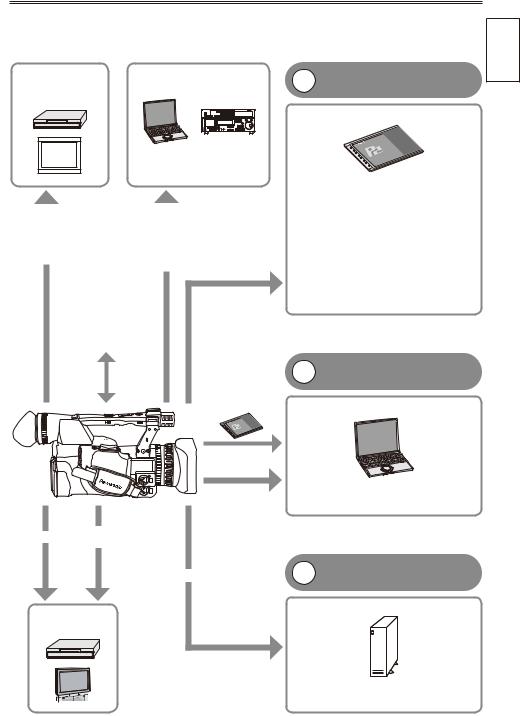
Outline of operations
This unit is compatible with P2 (Professional Plug-in) cards.
The P2 card has a large capacity with a high transfer rate, and allows you sophisticated movie-making on this handy camera, including HD (High Definition) recording and smooth editing/dubbing.
Video |
Computer/ |
equipment/ |
Memory card recorder |
Monitor |
|
|
|
|
The contents can be transferred |
|
as a data stream (digital |
|
dubbing). |
|
|
|
|
|
|
|
|
|
|
|
|
IEEE1394 |
|||
BNC cable |
|||||||
|
(Windows/ |
||||||
(HD-SDI) |
|
||||||
|
Macintosh) |
||||||
|
|
|
|
||||
The setting values such as the user file are saved to and read from the SD memory card.
P2 card
|
|
USB2.0 |
|
|
(Windows) |
|
|
IEEE1394 |
|
Component |
(Macintosh) |
AV cable |
|
|
video cable |
|
|
|
|
|
|
|
IEEE1394 (SBP-2*) |
Video equipment/
Television
1 |
P2 mode shooting and |
playback (Pages 24 and 62) |
P2 card
You can use the following features:
•HD (High Definition) recording
•Multi format recording
•Variable frame rates
Slow & quick motion recording
•Maximum 4 channel uncompressed digital audio recording
•DV recording (576i)
For details on how to handle recorded data, see Page 121.
2 PC mode (Page 80)
Computer
The data (file) is transferred for nonlinear editing on your computer or other unit.
3 1394 host mode (Page 82)
External hard disk
Before use
|
The unit directly controls the external hard disk |
|
|
drive, and transfers the data (file) to it. |
|
*Serial Bus Protocol-2 |
||
|
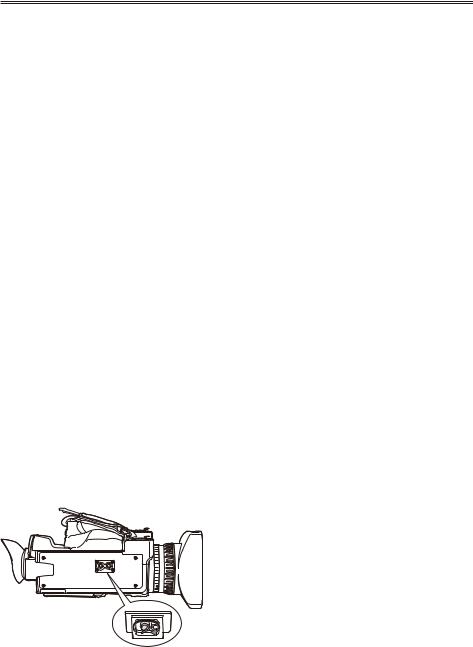
Precaution for use
Always take some trial shots before actual shooting.
•When shooting important events (such as weddings), always take some trial shots and check that the sound and images have been recorded properly before actual shooting.
Be sure to check and set the calendar and time zone.
•These settings affect the control and playback sequence of the recorded contents. Before making a recording, set and check the calendar and time zone. (Page 23)
Panasonic makes no guarantees for your recordings.
•Please understand that Panasonic makes no guarantees for your recordings in cases where images and/or sound were not recorded as you intended due to problems with the camera-recorder.
Respect copyrights
•Copyright laws forbid the use of video and audio material you have recorded for any purpose other than your own personal enjoyment. Remember that restrictions apply to the shooting of certain material even if it is intended for private use.
Caution regarding laser beams
•The CCD may be damaged if it is subjected to light from a laser beam.
When using the camera-recorder in locations where laser irradiation equipment is used, be careful not to allow the laser beam to shine directly on the lens.
Notes when connecting a 1394 cable
•Windows:
Before connecting, turn off the main unit power, and check the shape and orientation of the terminal.
•Macintosh:
After turning on the power of the Apple Macintosh computer, check the shape and orientation of the terminal, and then connect the cable.
(Pages 76, 77)
Media that can be used in this unit
The following media can be used in this unit. For details, refer to the respective pages.
•P2 card (Pages 24, 121)
•SD/SDHC memory cards (Pages 28, 122)
Mounting the camera-recorder on a tripod
The tripod mounting hole is 5.5 mm deep. Do not force the tripod screw beyond this depth. You can damage the camera-recorder if you use any screw other than 1/4-20UNC.
Attach the tripod to the tripod hole.
For other usage notes, see Page 116.
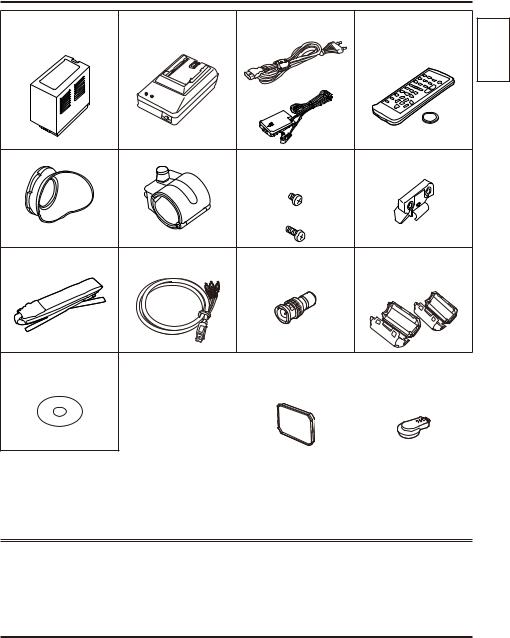
Accessories
Battery *1 |
AC Adapter |
AC power supply cord/ |
Wireless remote control |
|
|
DC cord |
and battery (CR2025) |
Eye cup |
Microphone holder |
Screws for microphone |
Microphone holder |
|
|
holder |
adapter |
|
|
6-mm screws (2) |
|
|
|
12-mm screws (2) |
|
Shoulder belt |
Component video cable |
PIN-BNC conversion |
30-mm ferrite core (2)*2 |
|
|
plugs (3) |
35-mm ferrite core (2)*2 |
CD-ROM |
The following accessories are attached to the |
|
|
camera-recorder. |
|
|
|
|
|
Lens hood |
INPUT terminal cover (2) |
|
|
|
Before use
*1 For part numbers for the battery, see “Optional units”. (see below)
*2 When using a 1394 cable (sold separately) or a USB cable (sold separately), attach ferrite cores to the both ends of the cable. (Page 76)
Optional units
•XLR microphone
AG-MC200G
•Battery
CGA-D54 (5400 mAh: equivalent to accessory battery)
About this manual
Note concerning illustrations in these instructions
•Illustrations (camera-recorder, menu screens, etc.) in these operating instructions differ slightly from the actual camera-recorder.
References
• References are shown as (Page @).
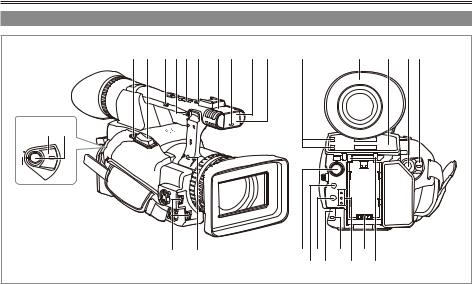
Description of parts
Right side and rear side
|
3 |
4 |
5 6 7 |
8 |
9 10 |
11 12 |
15 |
16 |
17 |
2 1 |
|
1 |
2 |
|
|
|
|
|
|
|
|
|
|
POWER |
|
|
|
|
|
|
|
|
|
|
|
ON |
|
|
|
|
|
|
|
|
|
|
|
OFF |
|
|
|
|
|
|
|
|
|
|
|
|
|
|
13 |
14 |
|
|
18 20 |
22 |
24 |
|
|
|
|
|
|
|
|
|
19 21 |
23 |
25 |
|
|
1 |
POWER switch (Page 18) |
13 |
INPUT 1/2 (audio input) switch (Page 50) |
2 |
START/STOP button (Page 24) |
14 |
Zoom ring pin hole (Page 29) |
3 |
REC CHECK button (Page 24) |
15 |
P2 card access lamp (x 2) (Page 25) |
4 |
Zoom button (Page 29) |
16 |
Viewfinder (Page 19) |
5 |
HANDLE ZOOM switch (Page 29) |
17 |
P2 card/SD memory card slot (cover) |
6 |
Recording enable/disable switch (Page 39) |
|
(Pages 24 and 28) |
|
|
||
7 |
Handle zoom button (Page 29) |
18 |
SCENE FILE dial (Page 52) |
|
|
||
8 |
Handle START/STOP button (Page 24) |
19 |
SLOT SEL button (Page 43) |
|
|
||
9 |
Built-in stereo microphone (Page 50) |
20 |
Mode button (Page 24) |
|
|
||
10 |
Tally lamp (Front) (Page 18) |
21 |
Remote control sensor (Rear) (Page 17) |
|
|
||
11 |
Remote control sensor (Front) (Page 17) |
22 |
Tally lamp (Rear) (Page 18) |
|
|
||
12 |
White balance sensor (Page 38) |
23 |
Mode lamp (Page 24) |
|
|
||
|
|
24 |
Power terminal (Page 15) |
|
|
25 |
Battery release button (Page 15) |
10
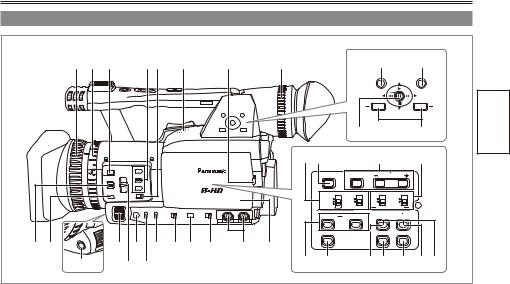
Left side |
|
|
|
|
|
|
|
|
|
|
|
|
|
|
|
|
1 |
2 |
3 |
|
4 5 |
6 |
7 |
8 |
|
|
22 |
|
23 |
|
|
|
|
|
|
|
|
|
|
|
|
|
MENU |
|
THUMBNAIL |
|
|
|
|
|
|
|
|
|
|
|
|
PUSH-SET |
|
|
of |
|
|
|
|
|
|
|
|
|
|
|
|
|
|
|
|
parts |
|
|
|
|
|
|
|
|
|
|
|
|
PAGE/AUDIO MON/VAR |
Description |
|||
|
|
|
|
|
|
|
|
|
|
24 |
|
|
25 |
|
|
|
|
|
|
|
|
|
|
26 27 |
|
28 |
|
29 |
|
|
|
|
|
|
|
|
|
|
|
|
BARS |
SHUTTER |
|
SELECT |
|
|
|
|
|
|
|
|
|
|
|
|
COUNTER |
RESET/TC SET |
ZEBRAREC OIS |
|
|
|
|
|
|
|
|
|
|
|
|
|
LCD |
|
EVF DTL |
WFM |
|
|
|
9 10 |
AWB |
|
12 14 |
16 |
17 18 19 |
20 |
21 |
|
|
|
|
|
|
|
|
|
11 |
|
13 |
15 |
|
|
30 |
31 |
32 33 |
34 |
3536 |
|
|
||
|
|
|
|
|
|
|
|
|
|
|
|
||||
1Focus ring (Page 34)
2Zoom ring (Page 29)
If you don’t need the zoom ring pin, fit it into the provided zoom ring pin hole (14 on page 10) so that you don’t loose it.
3FOCUS ASSIST button (Page 35)
4USER button (Page 41)
5ZOOM switch (Page 29)
6Built-in speaker (Page 74)
7OPEN button (Page 20)
8 Diopter adjustment dial (Page 19)
9FOCUS switch (Page 34)
10PUSH AUTO button (Page 34)
11AWB button (Page 37)
12IRIS dial (Page 35)
13ND FILTER switch (Page 36)
14IRIS button (Page 35)
15GAIN switch (Page 36)
16WHITE BAL switch (Page 37)
17FUCUS RING (FOCUS/IRIS) switch
(Page 34)
18DISP/MODE CHK button (Page 40)
19AUTO/MANUAL switch (Page 24)
20AUDIO LEVEL knobs (CH1, CH2) (Page 51)
21LCD monitor (Page 20)
22MENU button (Page 93)
23THUMBNAIL button (Page 65)
24Operation lever (Pages 62 and 93)
25PAGE/AUDIO MON/VAR button (Pages 42 and 73)
26CH1, CH2 SELECT switch (Page 50)
27BARS button (Page 41)
28SHUTTER, SPEED SELLECT +/- button
(Page 48)
29INPUT1, 2 switch (MIC POWER +48 V)
(Page 50)
30COUNTER - RESET/TC SET button
(Page 57)
31LCD button (Page 22)
32ZEBRA button (Page 39)
33EVF DTL button (Page 20)
34WFM button (Page 42)
35OIS button (Page 41)
36MCR REC button (Page 85)
Functions when the ZEBRA button (32) and OIS button (35) are pressed at the same time.
11
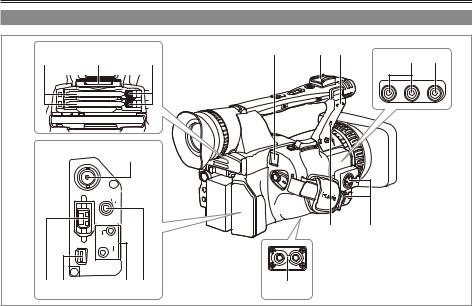
Description of parts (continued)
Terminals and mounting parts
4 |
|
5 |
1 |
2 |
3 |
15 |
16 |
|
6 |
|
|
||||
|
|
7 |
|
|
|
|
|
|
|
SDI |
|
|
|
|
|
|
1394OUT |
|
|
|
|
|
|
|
|
CAM REMOTE |
|
|
|
|
|
|
|
FOCUS IRIS |
|
13 |
|
14 |
|
|
|
|
|
|
|
|
|
|
COMPONENT |
ZOOM S/S |
|
|
|
|
|
|
OUT |
|
|
|
|
|
|
8 |
9 |
10 |
11 |
12 |
|
|
|
1USB terminal (Mini-B) (Page 76)
2Light shoe
3Microphone shoe (Page 75)
4P2 card slots (Page 24)
5SD memory card slot (Page 28)
6 P2 card eject buttons (Page 27)
7SDI OUT terminal (Page 79)
81394 terminal (Pages 76 and 77)
9COMPONENT OUT terminal (Page 79)
10CAM REMOTE jack* FOCUS/IRIS (3.5 mm mini jack)
You can connect a remote control unit to control the FOCUS and IRIS (aperture). ZOOM S/S (2.5 mm super mini jack)
You can connect a remote control unit to control zoom and start/stop of recording.
11Headphone jack (3.5 mm stereo mini jack)
(Page 75)
12Tripod hole (Page 8)
13Security Lock opening
Use this opening to attach a security cable. For details on how to attach the cable, see the Operating Instructions supplied with the cable. The security lock and security cable are designed to prevent theft, but Panasonic will not accept any liability for damages resulting from theft.
14INPUT 1/2 terminal (XLR, 3 pin) (Page 75)
15AUDIO OUT CH1/CH2 terminals (Page 79)
16VIDEO OUT terminal (Page 79)
*Do not connect any equipment except the remote controller to the CAM REMOTE jack. Connecting any equipment other than the remote control may cause the image brightness to
change and/or the images to appear out of focus.
12
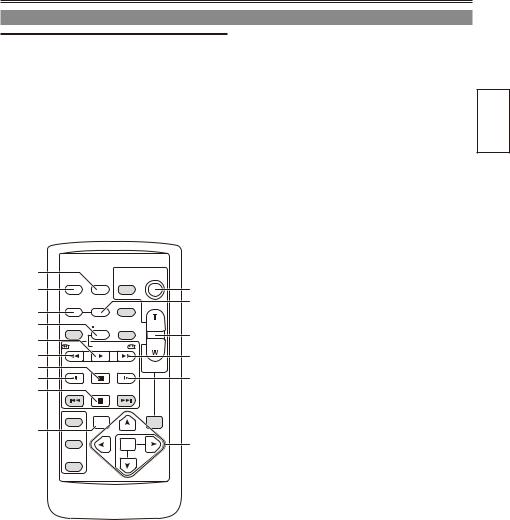
Remote control
The following buttons are for functions that cannot be executed on the camera-recorder.
• PHOTO SHOT |
• TITLE |
• A.DUB |
• MULTI/P-IN-P |
• SELECT |
|
• STORE |
• OFF/ON |
|
• PB.ZOOM |
• INDEX |
|
|
|
|
1 |
|
DATE/ |
PHOTO |
|
START/ |
|
OSD |
|
STOP |
|
|||
2 |
TIME |
SHOT |
|
|
12 |
|
|
|
|
|
|
||
3 |
COUNTER RESET |
TITLE |
|
ZOOM |
4 |
|
|
|
|
|
|
|
|
5 |
MULTI/ |
REC |
A.DUB |
|
|
|
P-IN-P |
+ |
|
13 |
|||
6 |
|
|
|
- VOL |
|
|
/REW |
PLAY |
FF/ |
|
|
|
|
7 |
|
|
11 |
|||
|
|
|
|
|
||
8 |
STILL ADV |
PAUSE |
STILL ADV |
|
|
|
9 |
|
|
|
|
|
9 |
10 |
INDEX |
STOP |
INDEX |
|
|
|
|
SELECT |
VAR. |
|
|
PB. |
|
|
|
|
|
|
||
14 |
|
SEARCH |
|
|
ZOOM |
|
STORE |
|
|
|
|
|
|
|
|
|
|
|
|
|
|
MENU |
15 |
OFF/ON |
|
SET |
|
|
|
P.B.DIGITAL |
|
ITEM |
|
|
1 DATE/TIME button (Page 74)
2OSD button (Page 74)
3COUNTER button (Page 57)
Same function as the COUNTER button on the main unit.
4COUNTER RESET button (Page 57) Same function as the COUNTER RESET button on the main unit.
5REC button (Page 85)
Operation buttons
6PLAY button ( Q) (Pages 62 and 85)
7 /REW button (T ) (Page 62)
/REW button (T ) (Page 62)
8PAUSE button ( H ) (Page 62)
Like the operation buttons of the camera, MENU operations are performed using SET button.
9STILL ADV button ( ,
,  ) (Page 17)
) (Page 17)
10STOP button ( G ) (Page 62)
11FF/  button ( Y) (Page 62)
button ( Y) (Page 62)
Buttons for shooting and volume control
12START/STOP button (Page 24)
Same function as the START/STOP button on the main unit.
13ZOOM/VOL buttons (Page 29)
14VAR. SEARCH button (Page 73)
15MENU button (Page 93)
Functions the same as the MENU button on the camera.
[  ], [
], [  ], [
], [  ], [
], [  ] buttons
] buttons
Function the same as the Operation lever on the camera.
Description of parts
13
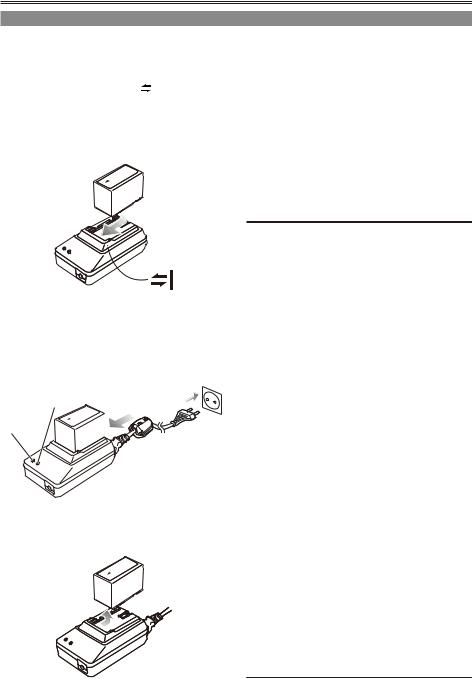
The battery
Charging
Before using the battery, fully charge it with the AC adapter.
Keep a spare battery with you.
1 Align the battery with |
|
marking on |
|
the AC adapter, place it flat, and slide it in the direction shown below.
•You cannot charge the battery if the DC cord is connected to the DC OUT connector, so disconnect it first.
2 Plug the AC cord into the power outlet.
•The POWER lamp and CHARGE lamp on the AC adapter light, and charging begins.
•If the CHARGE lamp does not light when attached, detach the battery and then attach it again.
CHARGE
POWER
•When the battery is charged, the CHARGE lamp on the AC adapter goes out.
3 Slide the battery and remove it.
Recording time of included battery
Capacity |
Recharging |
Continuous |
|
time |
recording time |
||
|
|||
5400 mAh |
Approx. 330 |
Approx. 160 |
|
min. |
min. |
||
|
•The times given above are approximate for when scenes are shot in the DVCPRO HD mode while not using the LCD monitor.
•The times apply when the ambient operating temperature is 20°C and humidity is 60%. Charging may take longer at other temperatures and humidity levels.
•Keep metal objects (such as necklaces and hairpins) away from the battery. Shortcircuiting may occur across the terminals, causing the battery to heat up, and you may seriously burn yourself if you touch the battery in this state.
•The battery becomes hot while it is being used or charged. The camera-recorder itself also becomes hot during use.
•The recordable time reduces if you repeatedly start and stop recording.
•Discharge the battery before storing it. When storing it for an extended time, charge it at least once a year, use up its charge in the camerarecorder, and then store it again.
•If the battery is extremely hot or cold, the CHARGE lamp will blink several times before charging starts.
•If the CHARGE lamp continues to blink even when the battery temperature is normal, there may be something wrong with the battery or AC adapter. Contact your dealer.
•The battery takes longer to charge when it is warm.
•The AC adapter can interfere with radio reception so keep radios at least 1 meter away from it.
•The AC adapter may make some noise when you are using it, but this is normal.
•You cannot charge the battery when supplying power to the camera-recorder from the AC adapter.
•Operation of battery pack CGR-D16 (1600 mAh) (sold separately) is not guaranteed.
14
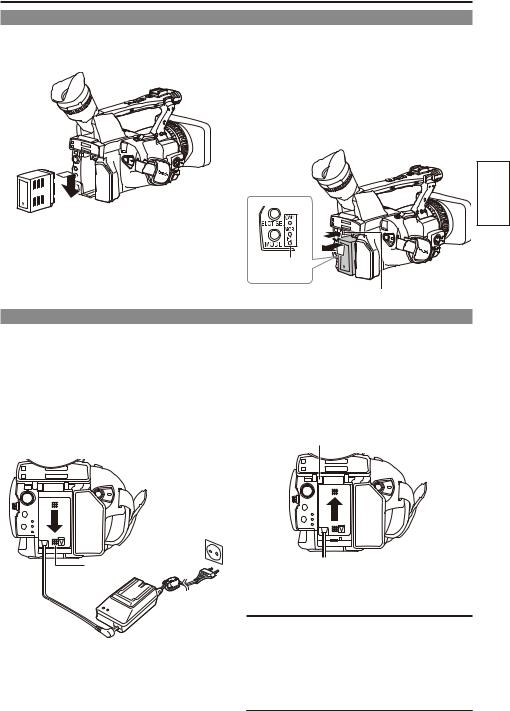
Installing and removing the power supply
Installing and removing the battery Installation
1 Insert the battery until it clicks into place.
Removal
1 Set the POWER switch to OFF, and check that the mode lamp is off.
2 While pressing the battery release button, raise up the battery to remove it.
•Support the battery with your hand to ensure that it
Mode lamp
Battery release button
Connecting and disconnecting the power cord
Installation
1 Connect the DC cord to the AC adapter.
2 Plug the AC power supply cord into the power outlet.
3 Slide the DC cord’s battery connector to the direction of the arrow until it clicks into
DC cord’s battery connector
Removal
1 Set the POWER switch to OFF, and check that the mode lamp is off.
2 Slide the DC cord’s battery connector to the direction of the arrow while pressing the battery release button.
Battery release button
3 Disconnect the AC power supply cord from the power outlet.
CAUTION:
•You cannot charge the battery when supplying power to the camera-recorder from the AC adapter.
•Disconnect the AC power supply cord from the power outlet when the unit is not going to be used.
15
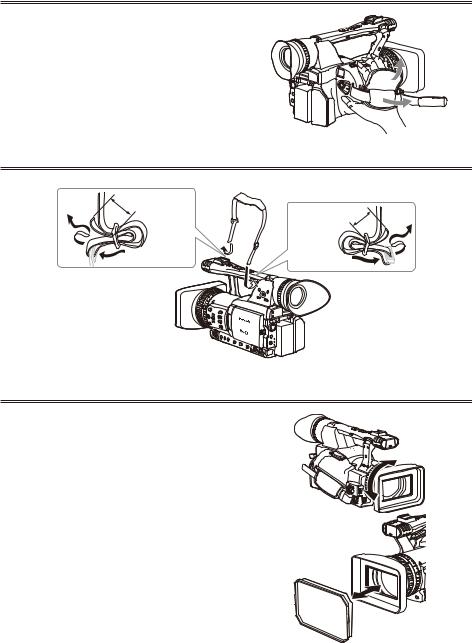
Adjusting the hand strap
Adjust the hand strap to suit your hand.
1
2
Open the cover and adjust the length.
Close the cover.
• Make sure the cover is fully closed.
Attaching the shoulder strap
Attach the shoulder strap and use it as a precaution against dropping the camera.
20 mm or more
20 mm or more
Detaching and attaching the lens hood
Detaching the lens hood
• Turn the lens hood counterclockwise to detach it.
Attaching the lens hood
• Turn the lens hood clockwise until it clicks to secure it in position.
• Be sure to attach the lens hood cap to protect the lens when not in use.
16
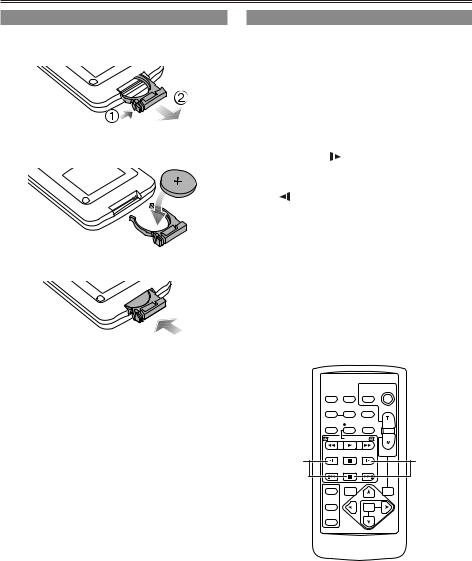
The remote control
Insert the battery
1 Push the catch in the direction shown by arrow to remove
2 Insert the battery with the “+” marked side facing up.
3 Return the holder to its original position.
•When the battery (CR2025) has run out, replace it with a new one. (The battery lasts about one year, depending on the frequency of use.)
If the remote control unit fails to work even when it is operated near the camera-recorder’s remote control sensor, the battery has run out.
•Keep the battery out of the reach of children.
Remote control setup
When using two camera-recorders simultaneously, set this camera-recorder and the remote control to either “operation mode 1” or “operation mode 2” so the remote control does not operate the wrong camera-recorder by mistake.
Setting
•Wireless remote control
Press the MCR operation buttons STOP ( G )
and STILL ADV |
) at the same time to set the |
|
remote control unit for use in “operation mode 1”. |
Preparation |
|
Alternatively, press the STOP ( G ) and STILL |
||
ADV ) buttons at the same time to set the |
|
|
remote control unit for use in “operation mode 2”. |
|
|
When the battery in the remote control unit is |
|
|
|
||
replaced, the remote control unit is set for use in |
|
|
“operation mode 1”. |
|
|
•Camera
In the setup menus, OTHER FUNCTIONS screen, REMOTE, set to 1 or 2. (Page 109)
If different settings are used for the camerarecorder and remote control unit, “REMOTE” lights
in red on the |
|
|
|
. |
|
|
DATE/ |
PHOTO |
START/ |
|
|
STOP |
||
|
OSD |
TIME |
SHOT |
|
|
COUNTER RESET |
TITLE |
ZOOM |
|
|
MULTI/ |
REC |
A.DUB |
|
|
P-IN-P |
+ |
||
|
|
|
|
- VOL |
|
/REW |
PLAY |
FF/ |
|
Operation |
STILL ADV |
PAUSE |
STILL ADV |
Operation |
|
|
|
||
mode 2 |
INDEX |
STOP |
INDEX |
mode 1 |
|
SELECT |
VAR. |
|
PB. |
|
|
|
||
|
|
SEARCH |
|
ZOOM |
STORE
|
MENU |
OFF/ON |
SET |
|
|
P.B.DIGITAL |
ITEM |
|
17
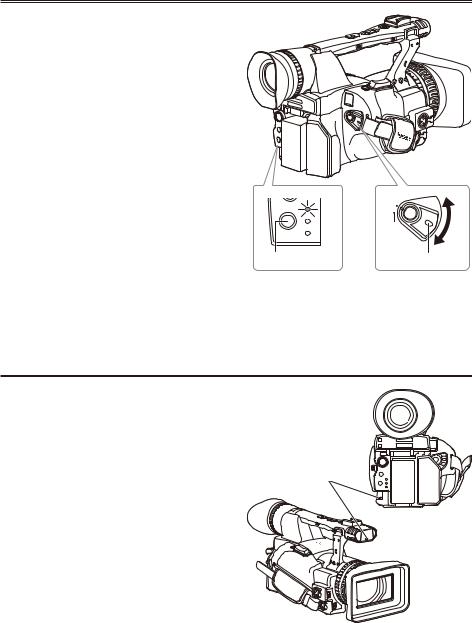
Turn on/off the camera
While pressing the lock release, turn the POWER switch.
Turn on the camera:
The mode lamp (CAM) lights red (CAM mode) and the camera is now in the shooting standby mode.
Turn off the camera:
The mode lamp (CAM) goes out.
•Power saving mode
When the camera is left idle in pause mode for about 5 minutes, it will behave as follows depending on what POWER SAVE settings have been made in the setting menu OTHER FUNCTIONS screen (Page 111).
ON: The camera-recorder turns off automatically. OFF:The camera-recorder does not turn off automatically.
See the setup menus, OTHER FUNCTIONS screen, POWER SAVE (Page 111) for details.
•When the operation mode buttons flash in sequence starting with the top one and the power then goes off, it means that there is no charge left in the battery. Recharge the battery.
Mode lamp |
POWER |
|
|
SLOT SEL CAM |
ON |
MCR |
|
PC |
OFF |
|
|
MODE |
|
Mode button |
Lock release |
Tally lamp |
|
|
The tally lamp can be made to light up during |
|
|
shooting by selecting “ON” as the REC LAMP |
|
|
setting in the OTHER FUNCTIONS screen. |
|
|
(Page 110) |
|
|
When the camera-recorder is in any of the |
|
|
following states, the tally lamp blinks. |
|
|
• When an operation initiated by the remote control |
Tally lamp |
|
unit has been received (8 blinks/sec.) |
||
|
||
• When the remaining battery capacity runs out (4 |
|
|
blinks/sec.) |
|
|
• When the available recording space on the P2 |
|
|
card or the battery power is low (1 blink/sec.) |
|
|
• When removing the P2 card during access (4 |
|
|
blinks/sec.) |
|
|
• When there is no recording space left on the P2 |
|
|
card (4 blinks/sec.) |
|
18
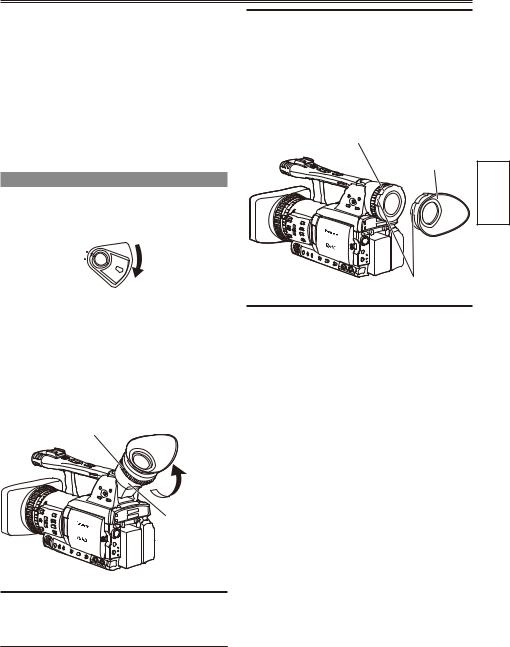
Viewfinder
This camera has two viewfinders; one is a miniature LCD in the viewfinder and the other is a retractable 3.5-inch LCD.
Use the viewfinder that best suits the application and shooting conditions.
•The brightness and hue may differ between the images appearing on the viewfinder and LCD monitor and those displayed on a TV monitor.
To see how the final images will appear, check them on a TV monitor.
•Images are always displayed on the viewfinder.
Using the viewfinder
1 Set the POWER switch to ON and check that images appear in the viewfinder.
• Keep the LCD monitor closed.
POWER
ON
OFF
Fitting the eye cup
Attach the eye cup by aligning the projections on the eye cup holder and eye cup and fitting them together.
•Turning the eye cup after attaching it may cause the eye cup holder to come off. If the eyecup holder does come off, see “Cleaning the Viewfinder” (Page 119) for details on how to refit it.
Eye cup holder
Eye cup
Projection
2 Adjust the viewfinder’s angle so that the screen is positioned where it is easiest to see.
•You can move the view finder out to about 90 degrees perpendicular to the camera.
3 Adjust the diopter adjustment lever so that you can see the characters on the viewfinder screen clearly.
Viewfinder diopter dial
Eye piece
Preparation
Do not point the eye piece at the sun or other strong light source.
•Light concentrated by the lens could damage internal components and poses a fire hazard.
19
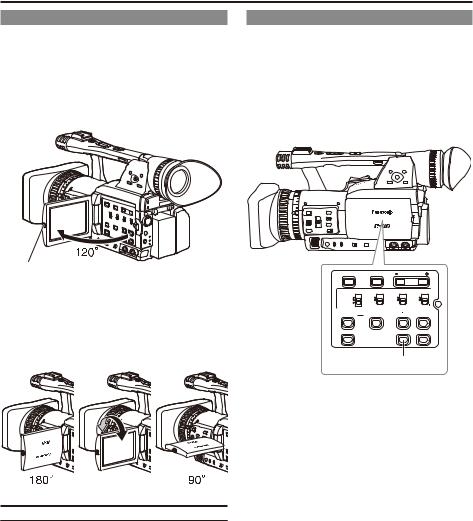
Viewfinder (continued)
Using the LCD
1 Set the POWER switch to ON.
2 Hold down the OPEN button to open the LCD monitor.
•It can open out to 120 degrees. Do not try to open it further as this will damage the camera.
OPEN button
3 Position the LCD monitor where it is easiest to see.
•The monitor can be rotated 180 degrees toward the lens and 90 degrees toward you.
•Do not apply unnecessary force to the open LCD. This can damage the camera.
• Ensure the LCD is fully closed.
Emphasizing outlines
Emphasizing the outlines of the images you see in the viewfinder or on the LCD makes it easier to focus.
Emphasizing the outlines does not effect the images you shoot.
1 In CAM mode, press EVF DTL.
“EVF DTL ON” appears on the screen for
BARS |
SHUTTER |
SELECT |
|
COUNTER |
RESET/TC SET |
ZEBRAREC |
OIS |
LCD |
|
EVF DTL |
WFM |
EVF DTL button
Press EVF DTL again to return to the original display. “EVF DTL OFF” appears on the screen for about 2 seconds.
20
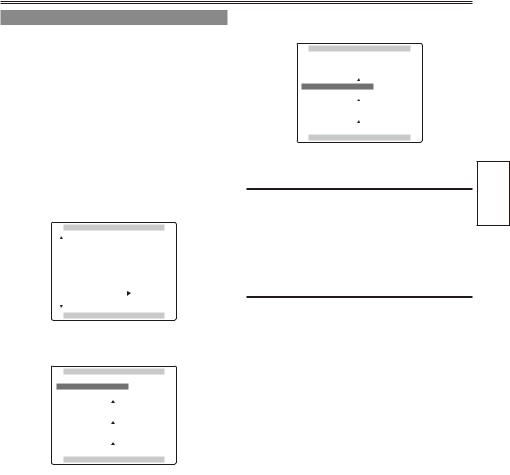
Adjusting the screen display
1 Set the POWER switch to ON. (Page 18)
2 Press the MENU button.
•For menu operation (Page 93)
•You can also use the menu buttons on the remote control. (Page 13)
3 Viewfinder adjustments
Select YES under EVF SET on the setting menu DISPLAY SETUP screen.
LCD monitor adjustments
Set YES under LCD SET on the setting menu screen.
DISPLAY SETUP
ZOOM·FOCUS |
NUMBER |
|
CARD/BATT |
ON |
|
P2CARD REMAIN |
TOTAL |
|
OTHER DISPLAY |
PARTIAL |
|
LCD BACKLIGHT |
NORMAL |
|
LCD SET |
–––– |
|
EVF SET |
|
–––– |
SELF SHOOT |
MIRROR |
|
PUSH MENU TO RETURN
4 Push the Operation lever in the E or R direction to select the item.
EVF SET
EVF COLOR LEVEL
[–] –––––––– –––––––– [+]
EVF BRIGHTNESS
[–] –––––––– –––––––– [+]
EVF
[–] –––––––– –––––––– [+]
PUSH |
TO RETURN |
5 Push the Operation lever in the W or Q direction to make adjustment.
EVF SET
EVF COLOR LEVEL
[–] ––––––––+–––––––– [+]
EVF BRIGHTNESS
[–] ––––––––+–––––––– [+]
EVF CONTRAST
[–] ––––––––+–––––––– [+]
PUSH MENU TO RETURN
6 Press MENU three times to exit the menus.
•You can return the settings for EVF SET and LCD SET to the factory settings by selecting the item and pressing COUNTER RESET (if it is possible to change the item at that time).
•The viewfinder display can be in color or black and white. (See the setup menus, DISPLAY SETUP screen, EVF COLOR.) The resolution is the same for both of them.
Preparation
21
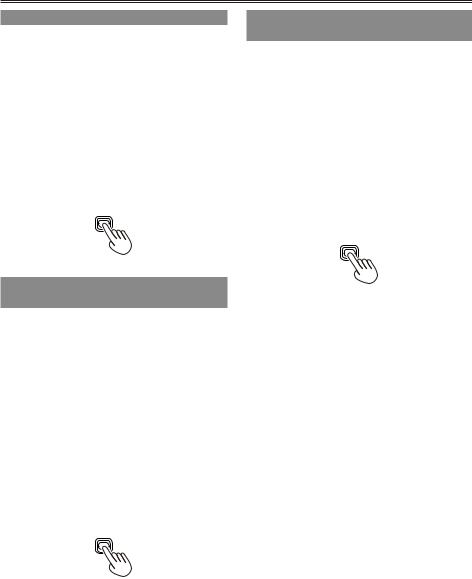
Viewfinder (continued)
Adjusting the backlight
The steps below show how to set the brightness of the LCD monitor to one of three possible levels.
1 Select LCD BL under LCD on the setting menu SW MODE screen.
This assigns LCD BL to the LCD button.
2 Press the LCD button.
Each press of the button switches backlight brightness in the following order: NORMAL (standard) " LOW (dark) " HIGH (bright) " NORMAL.
• These settings persist even when the camera-recorder is turned off.
LCD
Flipping images vertically and horizontally
Use this function to flip an image vertically or horizontally to check the aspect ratio or composition on the LCD monitor.
This feature affects only the image in the viewfinder or on the LCD monitor, not the recorded image.
1 Select LCD REV under LCD on the setting menu SW MODE screen.
This assigns LCD REV to the LCD button.
2 Press the LCD button.
•This button toggles between the normal and flipped image at each press.
•No screens are displayed when the image is flipped.
•The unit returns to normal image mode the
next time it is powered up.
LCD
Switching between overscan and underscan
Use this function to underscan or overscan the image shown in the viewfinder or on the LCD monitor.
1 Select OVERSCAN under LCD on the setting menu SW MODE screen.
This assigns OVER SCAN to the LCD button.
2 Press the LCD button.
•This button toggles between overscan and underscan at each press.
•The unit returns to underscan mode the next time it is powered up.
•In overscan mode, a frame appears on the
screen.
LCD
22
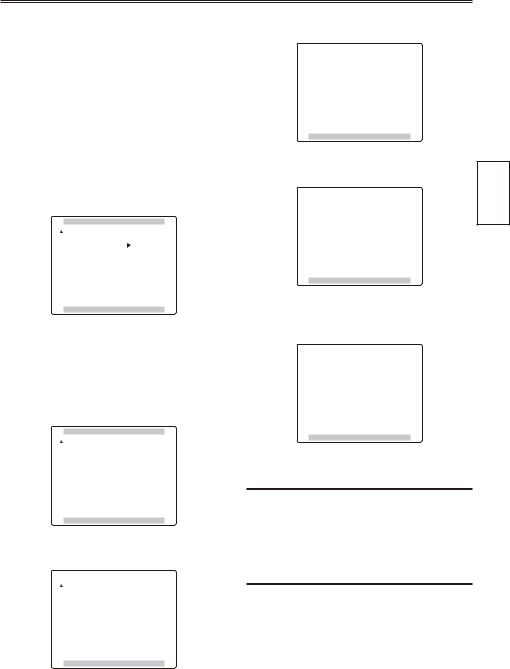
Setting the calendar
The CLOCK SET value is recorded in the contents (clip), and affects the sequence of playback of the thumbnails. Before carrying out recording, be sure to check and set CLOCK SET and TIME ZONE.
This shows you how to adjust the calendar to 5:20 PM on December 25, 2008.
1 Set the POWER switch to ON. (Page 18)
2 Press the MENU button.
3 Push the Operation lever in the E or R direction to set the time difference from Greenwich Mean Time under TIME ZONE on the setting menu OTHER FUNCTIONS screen. (Page 110)
OTHER FUNCTIONS
CLOCK SET |
–––– |
TIME ZONE |
+0:00 |
6 Push the Operation lever in the R direction to move to the MONTH setting.
|
|
CLOCK SET |
|
YEAR |
2008 |
||
MONTH |
|
OCT |
|
DAY |
01 |
||
HOUR |
12 |
||
MIN |
00 |
||
+/– : PUSH Y / T SEL : PUSH Q / G
PUSH MENU TO RETURN
7 Push the Operation lever in the W or Q direction to set MONTH to DEC.
|
|
CLOCK SET |
|
YEAR |
2008 |
||
|
|
|
DEC |
MONTH |
|
||
DAY |
01 |
||
HOUR |
12 |
||
MIN |
00 |
||
POWER SAVE |
OFF |
MENU INIT |
–––– |
OPERATION |
00012H |
OPERATION |
00012H |
EVF SET |
–––– |
SELF SHOOT |
MIRROR |
PUSH MENU TO RETURN
(Example of MENU in the CAM mode)
•For menu operation (Page 93)
•You can also use the menu buttons on the remote control. (Page 13)
4 In the setup menus, OTHER FUNCTIONS screen, CLOCK SET, select YES.
OTHER FUNCTIONS
CLOCK SET |
|
–––– |
|
TIME ZONE |
|
|
|
YES |
|||
POWER SAVE |
OFF |
||
MENU INIT |
–––– |
||
+/– : PUSH Y / T SEL : PUSH Q / G
PUSH MENU TO RETURN
8 Set DAY, HOUR, and MIN using the method shown in steps 4 and 5.
• This is a 24-hour clock.
|
|
CLOCK SET |
|
YEAR |
2008 |
||
MONTH |
|
DEC |
|
DAY |
25 |
||
HOUR |
17 |
||
MIN |
|
20 |
|
+/– : PUSH Y / T SEL : PUSH Q / G
PUSH MENU TO RETURN
9 Press MENU three times to exit the menus.
OPERATION |
00012H |
OPERATION |
00012H |
EVF SET |
–––– |
SELF SHOOT |
MIRROR |
PUSH MENU TO RETURN
5 Push the Operation lever in the W or Q direction to set YEAR to 2008.
|
|
CLOCK SET |
|
|
|
|
2008 |
YEAR |
|
||
MONTH |
|
OCT |
|
DAY |
01 |
||
HOUR |
12 |
||
MIN |
00 |
||
+/– : PUSH Y / T SEL : PUSH Q / G
PUSH MENU TO RETURN
Choose a year between 2000 and 2030.
•The clock can vary in accuracy so check that the time is correct before shooting.
•When using the camera overseas, do not set the CLOCK SET option to the local time, but instead enter the time difference from Greenwich mean time according to TIME ZONE.
Preparation
23
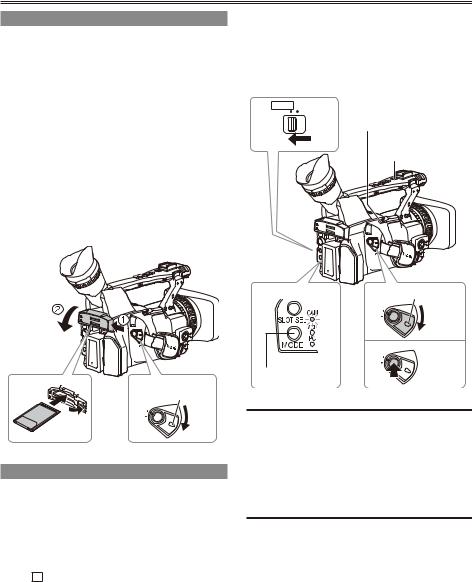
Basic shooting operations
Preparing to shoot
1 Set the POWER switch to ON. (Page 18)
2 Lift up the viewfinder, press the side of the card slot cover (A), and slide the cover (B) to open it.
3 Insert the P2 card securely in the card slot.
4 Push the P2 card eject button to the direction of the arrow, and close the card slot cover.
•There are two card slots.
•Be absolutely sure to close the card slot covers to keep the dust out.
•Do not remove the P2 card while the P2 card access lamps are blinking orange. (Page 25)
3 |
|
1 releaseLock |
|
|
POWER |
|
4 |
ON |
|
OFF |
Shooting in auto mode
1 Turn the POWER switch to ON. (Page 18)
•Check that the mode lamp (CAM) is lighted red.
2 Switch the AUTO/MANUAL switch to AUTO to select auto mode.
•“ A ” appears on the viewfinder and LCD screens.
•The focus, gain, iris and white balance are adjusted automatically.
3 Press the START/STOP button (Red) on the
POWER switch to start shooting.
•Press again to return to the camera to the shooting standby mode.
•Use the handle START/STOP button to make it easier to shoot from low angles.
2 |
AUTO MANUAL |
REC CHECK |
|
LCD |
|
|
button |
|
|
side |
|
|
|
Handle START/STOP button
Mode lamp |
1Lock release |
|
POWER |
|
ON |
|
OFF |
|
3 ONPOWER |
Mode button |
OF |
Under the following circumstances, even if you press the STOP button it may take some time until the writing to the P2 card finishes. For this reason, the operation will not be acknowledged if you press the START button too soon.
•Stopped after only a short recording time
•Stopped immediately after the recording has moved to a second P2 card
24
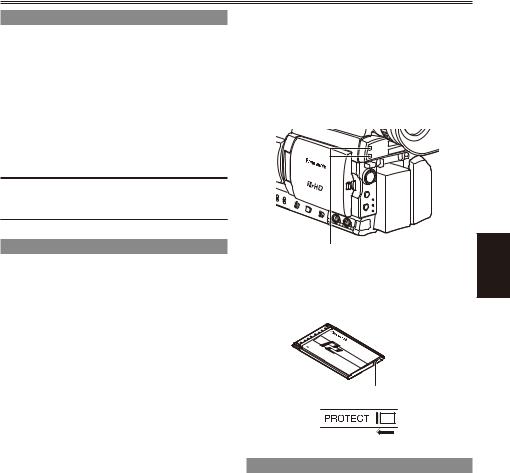
Checking photos taken (REC CHECK)
In the shooting pause mode, press the REC CHECK button.
This plays back about 2 seconds of the video and audio of the most recently recorded clip before returning to pause mode.
•Note that this REC CHECK portion will also be recorded to any equipment you have set up to make backup recordings.
•The REC CHECK function does not work in PC and MCR mode.
The HD recording(1080i/50i) settings are already made in the default mode. (To view the current settings, see Page 40.)
P2 card access lamps
CAM mode (MCR) Lights green:
Data can be saved onto the cards or loaded from them.
Blinks green (slow):
No available space on card, card is writeprotected
Lights orange:
Slot that is the object of recording
Blinks orange:
Data is now being accessed.
Blinks orange (fast):
A card is now being recognized.
Both lamps blink orange:
Ejection of card during access
Off:
Cards have not been inserted or formatted. Insertion of incompatible card.
PC mode (USB DEVICE)
Blinks orange: Data is now being accessed. Off: A status other than access underway.
PC mode (1394 DEVICE)
Blinks orange: Connected
Off: Not connected
PC mode (1394 HOST) Lights green:
Access standby.
Blinks orange:
Data is now being accessed.
Off:
Cards have not been inserted or formatted. Insertion of incompatible card.
P2 card access lamp |
Shooting |
|
|
||
Protecting against a possible erasure |
||
|
Switch the write-protect switch of the P2 card to [PROTECT].
Write-protect switch
Formatting P2 cards
1 Set the POWER switch to ON. (Page 18)
2 Press the mode button and set it to MCR mode (the MCR lamp lights).
• Thumbnails are displayed.
(Continued on the next page)
25
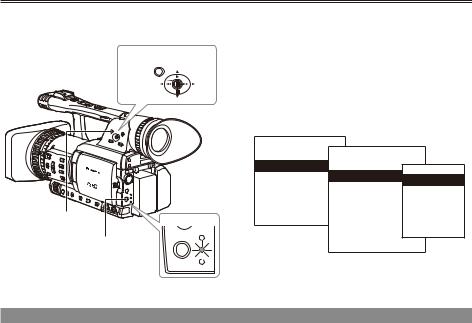
Basic shooting operations (continued) |
|
|
|
||
3 Press the MENU button. |
|
4 On the menu, select OPERATION and then |
|||
• For menu operation (Page 93) |
|
FORMAT. (Page 67) |
|
||
Operation lever |
• A screen such as the one shown below |
||||
appears. Select the number of the slot |
|||||
MENU |
|
||||
PUSH-SET |
|
into which you inserted the P2 card to |
|||
|
be formatted. Select EXIT to cancel the |
||||
|
|
||||
|
|
formatting. |
|
|
|
|
|
• When you press the MENU button, the menu |
|||
|
|
display disappears. |
|
||
|
|
THUMBNAIL |
DELETE |
|
|
|
|
OPERATION |
|
||
|
|
FORMAT |
|
||
|
|
PROPERTY |
SLOT1 |
||
|
|
REPAIR CLIP |
|||
|
|
META DATA |
SLOT2 |
||
|
|
|
|||
|
|
EXIT |
RE-CONNECTION |
||
MENU button |
Mode lamp |
|
SD CARD |
||
|
EXCH.THUMBNAIL |
||||
|
|
||||
|
SLOT SEL CAM |
|
|
EXIT |
|
Mode button |
|
EXIT |
|
||
MCR |
|
|
|
||
|
|
|
|
||
|
PC |
|
|
|
|
|
MODE |
5 SelectYES on the confirmation screen. |
|||
|
|
||||
|
|
• The selected P2 card is formatted. |
|||
Recording times
Card model |
Capacity |
DVCPRO/DV 2- |
DVCPRO50 4- |
DVCPRO HD*1 |
DVCPRO HD |
|
channel audio |
channel audio |
720P/25PN |
||||
|
|
|
||||
|
|
|
|
|
|
|
AJ-P2C004HG |
4 GB |
approx. 16 min. |
approx. 8 min. |
approx. 4 min. |
approx. 8 min. |
|
|
|
|
|
|
|
|
AJ-P2C008HG |
8 GB |
approx. 32 min. |
approx. 16 min. |
approx. 8 min. |
approx. 16 min. |
|
|
|
|
|
|
|
|
AJ-P2C016RG |
16 GB |
approx. 64 min. |
approx. 32 min. |
approx. 16 min. |
approx. 32 min. |
|
AJ-P2C032RG |
32 GB |
approx. 128 min. |
approx. 64 min. |
approx. 32 min. |
approx. 64 min. |
|
|
|
|
|
|
|
•The AJ-P2C002SG (2 GB) card cannot be used.
•The displayed available space includes the management area, and so the space available for recording is smaller than this.
•Concerning the division of clips recorded on P2 cards
When using a P2 card of at least 8 GB in this camera, if the continuous recording time for a single session exceeds the time shown in the following table, recording will be automatically resumed as a different clip. When performing a thumbnail operation (display, delete, restore, copy, etc.) on clips using P2 cards, you can operate them as a single clip. When you are using non-linear editing software and a PC, for example, the clips are displayed individually.
Recording Format |
Recording times |
|
|
DVCPRO HD*1 |
approx. 5 min. |
DVCPRO50 |
approx. 10 min. |
DVCPRO/DV |
approx. 20 min. |
*1 The 720P/25PN formats are not included in the DVCPRO HD recording format.
•When using any other types of cards, the driver installed in the camera-recorder may need to be updated. (Page 118)
•For the latest information not available in the Operating Instructions, visit the P2 Support Desk at the following Web sites.
https://eww.pavc.panasonic.co.jp/pro-av/
26

Remove the P2 card
1 Lift up the viewfinder, press the side of the card slot cover (A), and slide the cover (B) to open it.
2 Check that the P2 card access lamp is not blinking orange.
3 Raise the P2 card eject button and press it.
4 Remove the P2 card.
P2 card |
P2 card eject |
access lamp |
button |
4 |
3 |
•Do not eject the P2 card or turn the power off under the following circumstances, since doing so may cause a malfunction in the card:
1)While the orange P2 card access lamp is blinking after the card is inserted (and until it stops blinking).
2)During recording, during the recording finish process, or while the access lamp is blinking.
•If a P2 card is ejected during formatting or while its data is being accessed, “TURN POWER
OFF” appears in the viewfinder, and a warning is indicated by the tally lamp. If this happens, turn the power off and back on again.
• When a card is ejected during formatting: Format the card again.
• When a card is ejected while its data is being accessed:
The clips may be thrown out of order. (Page 56) Check the clips and repair them. (For details on repairing clips, see Page 67.)
•Immediately after pre-recording, a P2 card inserted into an empty slot will not be immediately recognized.
•During playback, a P2 card inserted into the empty slot will not be recognized and the P2 card access lamp will not light. When playback is completed, the P2 card recognition will begin.
•You can use ACCESS LED on the OTHER FUNCTIONS screen to set the P2 card access lamps so that they will always be off. In this case, either turn off the power or wait until enough time has passed after inserting the cards or stopping operation before ejecting the cards.
•If a P2 card is ejected while thumbnails are displayed, the thumbnail screen is released.
Cautions in using P2 cards
Before using a P2 card, be sure to format it with a P2 device.
Shooting
27

Using SD/SDHC memory cards
You can use SD and SDHC memory cards (the term “SD memory card” is used for both hereafter) to save and load SCENE files and USER files, and to upload clip meta data. (Page 54)
Installing and removing the SD memory card
Installation
1 Lift up the viewfinder, press the side of the card slot cover (A), and slide the cover (B) to open it.
2 Insert the card while making sure it is oriented in the proper direction.
Access lamp
3 Close the card slot cover.
Removal
1 Open the card slot cover, and check that the access lamp is not lit.
2 Press the card further into the unit, grasp the card, and then remove.
3 Close the card slot cover.
Formatting SD memory card
1 Set the POWER switch to ON. (Page 18)
2 Press the mode button and set it to MCR mode (the MCR lamp lights).
3 Press the MENU button.
4 On the menu, select OPERATION, FORMAT and then SD CARD. (Page 67)
• Select EXIT to cancel the formatting.
THUMBNAIL |
|
|
|
|
|
|
|
DELETE |
|
|
|
||
|
|
|
|
|
||
OPERATION |
|
FORMAT |
|
|
|
|
PROPERTY |
|
|
SLOT1 |
|||
|
REPAIR CLIP |
|
||||
META DATA |
|
|
SLOT2 |
|||
RE-CONNECTION |
||||||
|
|
|||||
EXIT |
SD CARD |
|||||
EXCH.THUMBNAIL |
||||||
|
EXIT |
|||||
|
EXIT |
|
||||
|
|
|
|
|||
|
|
|
|
|
|
|
5 SelectYES on the confirmation screen.
•The selected SD memory card is formatted.
•You can also format from the SD CARD FORMAT option on the CARD FUNCTIONS screen. (Page 109)
•With SDHC cards, 32 KB of capacity will have been used.
Cautions in using SD memory cards
•SD memory cards used with the AG-HPX172EN should conform to SD or SDHC standards. Be sure to format cards using the AG-HPX172EN. SD memory cards with the following capacity can be used for the AG-HPX172EN.
SD (from 8 MB to 2 GB):
8 MB 16 MB 32 MB 64 MB 128 MB 256 MB 512 MB 1 GB 2 GB
SDHC (4 GB to 16 GB):
4 GB 8 GB 16 GB
For the latest information not available in the Operating Instructions, visit the P2 Support Desk at the following Web sites.
https://eww.pavc.panasonic.co.jp/pro-av/
•SD memory cards must not be used or stored in an environment where they may be Exposed to high temperatures/humidities;
Exposed to water droplets; or Electrically charged.
•Be sure always close the cover when using an SD memory card.
•See also “Checkpoints for using memory cards” on Page 122.
28
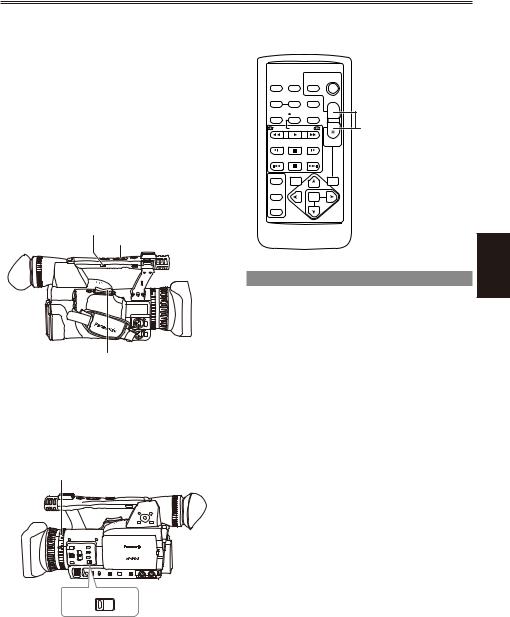
Using the zoom function
This camera has a 13 x optical zoom function. Zoom with the zoom button or the zoom ring.
Zoom button
Set the ZOOM switch to SERVO so that you can use the motor-driven zoom.
|
T : |
Zoom in |
|
W : |
Zoom out |
Gently press the zoom button on the grip to zoom slowly, firmly press to zoom faster.
You can change the zoom speed on the handle zoom button by selecting one of three speeds with the HANDLE ZOOM switch.
Set the HANDLE ZOOM switch speeds by going to the setup menus, SW MODE screen HANDLE ZOOM (Page 100).
HANDLE ZOOM switch
Handle zoom button
Zoom button
Zoom ring
Set the ZOOM switch to MANUAL so that you can use the zoom ring.
•You cannot use the zoom ring if the ZOOM switch is set to SERVO. Trying to use it could damage the camera.
Zoom ring
MANUAL SERVO
SERVO
ZOOM
On the remote control
Press ZOOM/VOL to zoom with the motor drive.
•medium.
|
DATE/ |
PHOTO |
START/ |
|
|
STOP |
|
||
OSD |
TIME |
SHOT |
|
|
COUNTER RESET |
TITLE |
ZOOM |
|
|
MULTI/ |
REC |
A.DUB |
|
|
P-IN-P |
+ |
|
||
|
|
|
-VOL |
|
/REW |
PLAY |
FF/ |
ZOOM/VOL button |
|
STILL ADV |
PAUSE |
STILL ADV |
|
|
INDEX |
STOP |
INDEX |
|
|
SELECT |
VAR. |
|
PB. |
|
|
|
|
||
|
SEARCH |
|
ZOOM |
|
STORE |
|
|
|
|
|
|
MENU |
|
|
OFF/ON |
|
|
SET |
|
|
|
|
|
|
P.B.DIGITAL |
|
|
ITEM |
|
|
|
|
|
|
Digital zoom function |
Shooting |
|||
Assign the D.ZOOM function to any of the USER
1 – 3 buttons to enable use of the digital zoom.
(Page 41)
Each press of the USER button to which D.ZOOM is assigned switches the zoom ratio in the following order: OFF (x1) " x2 " x5 " x10 " OFF (x1).
•The viewfinder and the LCD monitor indicate the zoom ratio when a setting other than OFF (x1) is selected.
•Digital zoom is available only in the 1080i/50i format.
•Digital zoom is not available when OFF is selected under DRS (Page 98) on the setting menu SCENE FILE screen.
•While using the zoom function, the slow shutter is disabled. While using the slow shutter, you cannot use the digital zoom function.
•Digital zoom cannot be changed during recording.
29

Variable frame rates (VFR)
By taking full advantage of the special characteristics of P2 cards, this unit provides frame skipping (undercranking) recording and highspeed (overcranking) recording, which are actually movie techniques, without the use of a frame rate converter. (Either the 25PN mode must be set for this.)
Since the camera-recorder records only the effective frames (native recording), recording is possible for 2 times as long compared with recording in the 25P or 50P mode (standard recording).
25PN mode:
The camera-recorder shoots in the 25 fps native mode. The video signals delivering images at a rate of 25 fps are recorded in 25 frames. The signals are recorded only in the effective frames so recording is possible for 2 times as long.
|
|
|
|
|
|
|
|
|
|
|
|
|
«: effective frame |
|||
Camera-Recorder |
|
|
|
|
|
|
|
|
|
|
|
|
|
|
|
|
1 |
|
|
|
2 |
|
|
3 |
|
|
4 |
||||||
|
|
|
|
|
|
|
|
|
|
|
|
|
|
|
|
|
25P |
1 |
|
1 |
2 |
|
2 |
3 |
|
3 |
4 |
|
4 |
||||
|
|
|
|
|
|
|
|
|
|
|
|
|
|
|
|
|
|
|
|
|
|
|
|
|
|
|
|
|
|
|
|
|
|
|
|
|
|
|
|
|
|
|
|
|
|
|
|
|
|
|
|
1 |
|
|
2 |
|
|
3 |
|
|
4 |
|
|
||||
25PN |
1 |
2 |
3 |
4 |
•Before VFR shooting, you must set the recording frame rate and recording format ahead of time.
•You cannot change the frame rates while recording.
•VFR shooting is possible only in progressive-shooting mode with 720 vertical lines.
You can select any of 20 recording frame rates ranging from 12 frames per second (fps) to 50 fps. The list of formats that allow recording by the camera-recorder (Page 123).
There may be slight discrepancies between the recording frame rate displayed and the frame rate at which the images are actually recorded. Refer to the table below.
Indicated |
|
|
|
|
|
|
|
|
|
|
|
|
|
|
|
|
|
|
|
|
recording |
50 |
48 |
45 |
42 |
37 |
34 |
32 |
30 |
28 |
27 |
26 |
25 |
24 |
23 |
22 |
21 |
20 |
18 |
15 |
12 |
frame rate |
|
|
|
|
|
|
|
|
|
|
|
|
|
|
|
|
|
|
|
|
Actual |
|
|
|
|
|
|
|
|
|
|
|
|
|
|
|
|
|
|
|
|
recording |
50.00 |
48.08 |
45.00 |
41.67 |
36.76 |
34.09 |
32.14 |
29.76 |
28.13 |
27.17 |
26.04 |
25.00 |
24.04 |
23.15 |
22.06 |
20.83 |
19.74 |
17.86 |
15.00 |
12.50 |
frame rate |
|
|
|
|
|
|
|
|
|
|
|
|
|
|
|
|
|
|
|
|
30
